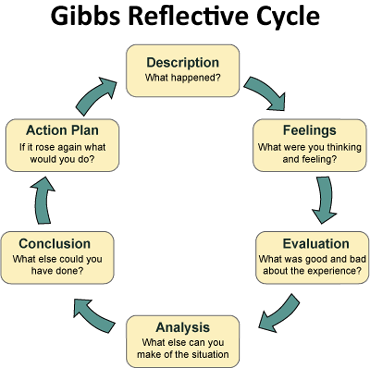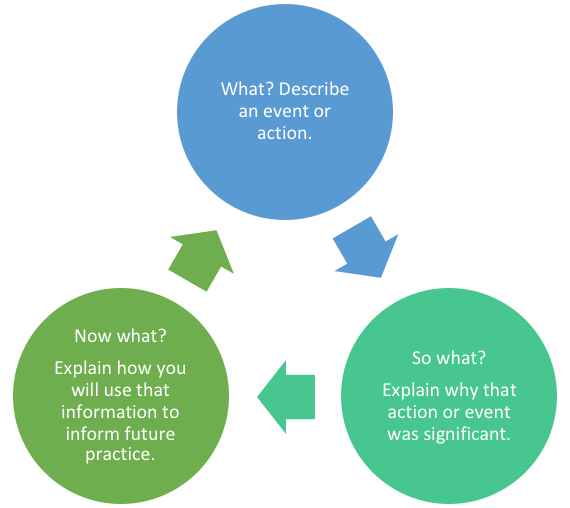Reflecting on an experience and analysing how you coped can help you to assess how you manage situations and learn how to improve in the future. Taking the time to reflect on a particularly difficult or successful situation can help us to break down what exactly about that situation caused us to react in that way and help us to either repeat or avoid such action in the future. Here we break down 2 reflective writing models used widely throughout academia in the UK.

Arguably the most common reflective cycle used in academia, this simple yet thorough reflective cycle is a firm favourite amongst academicians. It works through 6 stages and the cyclic process makes it particularly useful for repeated experiences.
The cycle starts with a DESCRIPTION; An explanation of what happened. Try and give a whole view of the experience, what would you want to hear if you were hearing about this experience for the first time? Think about who, where, when and how. Think about how it started and how it concluded.
Stage 2 of the cycle focuses on FEELINGS. Admit to how the situation made you feel, did you feel proud, underprepared, overwhelmed or perhaps out of your depth? Think what you would want to know if you hadn’t been there. Explain your feelings before, during and after the incident and how you felt other people involved may have felt and why that is important. Conclude with how you are currently feeling.
The EVALUATION comes next. Use this section to look into what the negatives and positives were. Be honest in this section, but it will be mostly brief. Think about how other people also contributed. At this stage, we are not discussing why that may have happened, that comes as part of the ANALYSIS. Here, we look at why things may have occurred this way. We can look at the overall picture from the previous steps of the cycle and address why things happened the way they did. Think about what academic literature can help you to understand this situation.
The CONCLUSION allows you to reflect on the experience as a whole. Summarise what happened and clearly define why it happened in that way. Reflect on what you have learnt from this.
The ACTION PLAN follows smoothly on from this, allowing you to put a plan in place to improve the same experience again in the future. This allows you to use the reflective experience to enable action in a real-world setting.
The cycle can then begin again the next time you do the same activity. Progression can then be seen when reflecting back through your papers.
Reference in Harvard: Gibbs, G., 1988. Learning By Doing. A Guide To Teaching And Learning Methods. Oxford: Oxford Brookes Further Education Unit.
Driscoll’s What Model

Driscoll’s ‘What? So What? Now What?’ reflective framework is a reflecting writing tool to hang your reflection on. This reflective framework is particularly useful to help you engage in critical reflection and think about how actions have consequences and how to progress for future learning. The three simple stages are easy to remember making it ideal for repeated use.
The three stages start with ‘What?’ What you must push yourself to do here is look deep into the incident. Think about what the situation is and how you got there, what was the outcome, was it positive or negative? Explain what your and other’s role in the situation was. Why is this situation a situation at all? What has happened to make you want to reflect? Think about the circumstances surrounding the event, and lastly explain how the consequences of the situation made you feel.
Once we have established the ‘What’ we need to reflect on the ‘So What?’. The idea behind this phase is to engage with wider reading to help you learn and make more of the experience; an opportunity to see what other theorists and academics have previously made of similar experiences in addition to why you might be feeling the way you are about it. From here, you will be able to assess how your actions impacted the result, and how or if you would do this differently in the future.
In the final section we ask ourselves ‘Now what?’. Give yourself the opportunity to learn from the experience and make a clear and defined plan to how you will tackle this situation in the future. Think about a clear step by step plan to implement for future use and your cycle of reflection should be complete! You have thought about what happened, what the consequence of the occurrence was and how to treat this in the future.
Reference in Harvard: Driscoll, J., 1994. Reflective practice for practise. Senior Nurse, 14(1), pp.47-50.
Reflective practice can feel a strenuous and time-consuming task at first, but like anything, the more you do it, the easier you will find it, and putting it to use in the real world will help you to realise how valuable this experience can be.